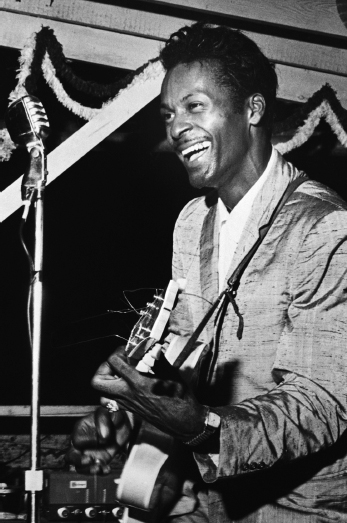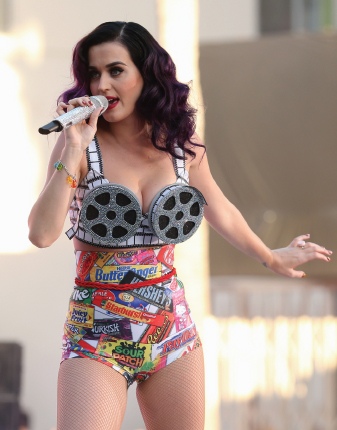Rock Muddies the Waters
In the 1950s, legal integration accompanied a cultural shift, and the music industry’s race and pop charts blurred. White deejay Alan Freed had been playing black music for his young audiences in Cleveland and New York since the early 1950s, and such white performers as Johnnie Ray and Bill Haley had crossed over to the race charts to score R&B hits. Meanwhile, black artists like Chuck Berry were performing country songs, and for a time Ray Charles even played in an otherwise all-white country band. Although continuing the work of breaking down racial borders was one of rock and roll’s most important contributions, it also blurred other long-standing distinctions between high and low culture, masculinity and femininity, the country and the city, the North and the South, and the sacred and the secular.
High and Low Culture
“The songs of Muddy Waters impelled me to deliver the down-home blues in the language they came from, Negro dialect. When I played hillbilly songs, I stressed my diction so that it was harder and whiter. All in all it was my intention to hold both the black and white clientele.”
CHUCK BERRY, THE AUTOBIOGRAPHY, 1987
In 1956, Chuck Berry’s “Roll Over Beethoven” merged rock and roll, considered low culture by many, with high culture, thus forever blurring the traditional boundary between these cultural forms with lyrics like: “You know my temperature’s risin’ / the jukebox is blowin’ a fuse … /Roll over Beethoven / and tell Tchaikovsky the news.” Although such early rock-and-roll lyrics seem tame by today’s standards, at the time they sounded like sacrilege. Rock and rollers also challenged music decorum and the rules governing how musicians should behave or misbehave: Berry’s “duck walk” across the stage, Elvis Presley’s pegged pants and gyrating hips, and Bo Diddley’s use of the guitar as a phallic symbol were an affront to the norms of well-behaved, culturally elite audiences. Such antics would be imitated endlessly throughout rock’s history.

The blurring of cultures works both ways. Since the advent of rock and roll, musicians performing in traditionally high culture genres such as classical have even adopted some of rock and roll’s ideas in an effort to boost sales and popularity. Some virtuosos like violinist Joshua Bell and cellist Matt Haimovitz (who does his own version of Jimi Hendrix’s famous improvisation of the national anthem) have performed in jeans and in untraditional venues like bars and subway stations to reinterpret the presentation of classical music.
Masculinity and Femininity
Rock and roll was also the first popular music genre to overtly confuse issues of sexual identity and orientation. Although early rock and roll largely attracted males as performers, the most fascinating feature of Elvis Presley, according to the Rolling Stones’ Mick Jagger, was his androgynous appearance.12 During this early period, though, the most sexually outrageous rock-and-roll performer was Little Richard (Penniman).
Wearing a pompadour hairdo and assaulting his Steinway piano, Little Richard was considered rock and roll’s first drag queen, blurring the boundary between masculinity and femininity. Little Richard has said that given the reality of American racism, he blurred gender and sexuality lines because he feared the consequences of becoming a sex symbol for white girls: “I decided that my image should be crazy and way out so that adults would think I was harmless. I’d appear in one show dressed as the Queen of England and in the next as the pope.”13 Little Richard’s playful blurring of gender identity and sexual orientation paved the way for performers like David Bowie, Elton John, Boy George, Annie Lennox, Prince, Grace Jones, Marilyn Manson, Lady Gaga, and Adam Lambert.
The Country and the City
Rock and roll also blurred geographic borders between country and city, between the black urban rhythms of Memphis and the white country & western music of Nashville. Early white rockers such as Buddy Holly and Carl Perkins combined country or hillbilly music, southern gospel, and Mississippi delta blues to create a sound called rockabilly. Conversely, rhythm and blues spilled into rock and roll. The urban R&B influences on early rock came from Fats Domino (“Blueberry Hill”), Willie Mae “Big Mama” Thornton (“Hound Dog”), and Big Joe Turner (“Shake, Rattle, and Roll”). Many of these songs, first popular on R&B labels, crossed over to the pop charts during the mid- to late 1950s (although many were performed by more widely known white artists). Chuck Berry borrowed from white country & western music (an old country song called “Ida Red”) and combined it with R&B to write “Maybellene.” His first hit, the song was No. 1 on the R&B chart in July 1955 and crossed over to the pop charts the next month.
Although rock lyrics in the 1950s may not have been especially provocative or overtly political, soaring record sales and the crossover appeal of the music itself represented an enormous threat to long-standing racial and class boundaries. In 1956, the secretary of the North Alabama White Citizens Council bluntly spelled out the racism and white fear concerning the new blending of urban/black and rural/white culture: “Rock and roll is a means of pulling the white man down to the level of the Negro. It is part of a plot to undermine the morals of the youth of our nation.”14 These days, distinctions between traditionally rural music and urban music continue to blur, with older hybrids such as country rock (think of the Eagles) and newer forms like “alternative country,” performed by artists like Ryan Adams, Steve Earle, Wilco, and Kings of Leon.
The North and the South
“[Elvis Presley’s] kind of music is deplorable, a rancid smelling aphrodisiac.”
FRANK SINATRA, 1956
“There have been many accolades uttered about [Presley’s] talent and performances through the years, all of which I agree with wholeheartedly.”
FRANK SINATRA, 1977
Not only did rock and roll muddy the urban and rural terrain, it also combined northern and southern influences. In fact, with so much blues, R&B, and rock and roll rising from the South in the 1950s, this region regained some of its cultural flavor, which (along with a sizable portion of the population) had migrated to the North after the Civil War and during the early twentieth century. Meanwhile, musicians and audiences in the North had absorbed blues music as their own, eliminating the understanding of blues as specifically a southern style. Like the many white teens today who are fascinated by hip-hop, Carl Perkins, Elvis Presley, and Buddy Holly—all from the rural South—were fascinated with and influenced by the black urban styles they had heard on the radio or seen in nightclubs. These artists in turn brought southern culture to northern listeners.
But the key to record sales and the spread of rock and roll, according to famed record producer Sam Phillips of Sun Records, was to find a white man who sounded black. Phillips found that man in Elvis Presley. Commenting on Presley’s cultural importance, one critic wrote: “White rockabillies like Elvis took poor white southern mannerisms of speech and behavior deeper into mainstream culture than they had ever been taken.”15
The Sacred and the Secular

Although many mainstream adults in the 1950s complained that rock and roll’s sexuality and questioning of moral norms constituted an offense against God, in fact many early rock figures had close ties to religion. Jerry Lee Lewis attended a Bible institute in Texas (although he was eventually thrown out); Ray Charles converted an old gospel tune he had first heard in church as a youth into “I Got a Woman,” one of his signature songs; and many other artists transformed gospel songs into rock and roll.
Still, many people did not appreciate the blurring of boundaries between the sacred and the secular. In the late 1950s, public outrage over rock and roll was so great that even Little Richard and Jerry Lee Lewis, both sons of southern preachers, became convinced that they were playing the “devil’s music.” By 1959, Little Richard had left rock and roll to become a minister. Lewis had to be coerced into recording “Great Balls of Fire,” a song by Otis Blackwell that turned an apocalyptic biblical phrase into a highly charged sexual teen love song that was banned by many radio stations, but nevertheless climbed to No. 2 on the pop charts in 1957. Throughout the rock-and-roll era to today, the boundaries between sacred and secular music and religious and secular concerns continue to blur, with some churches using rock and roll to appeal to youth, and some Christian-themed rock groups recording music as seemingly incongruous as heavy metal.